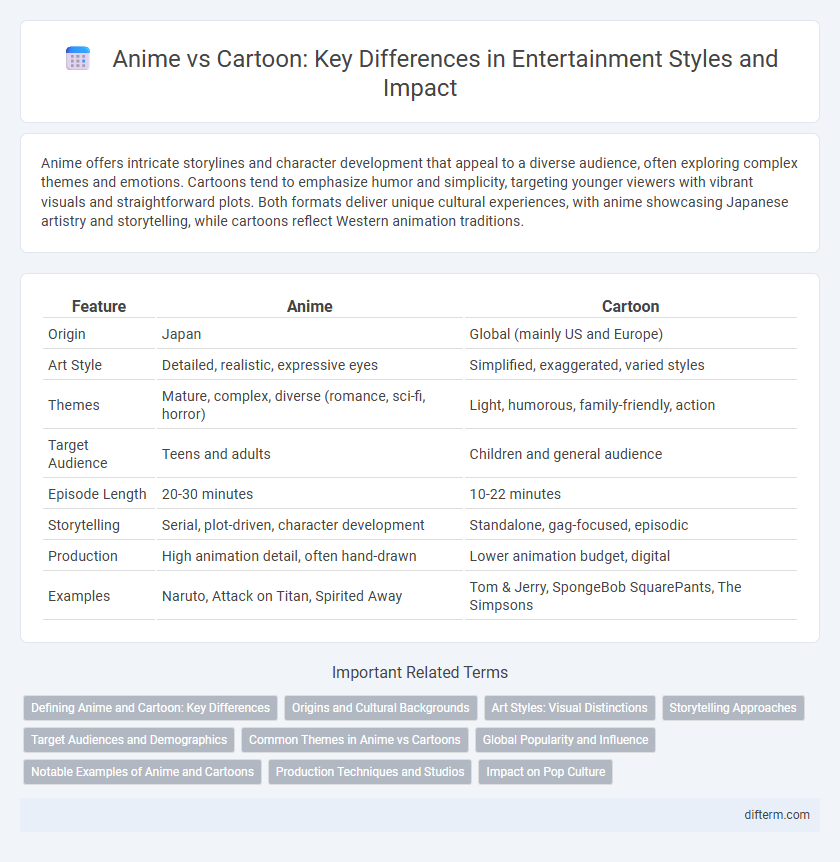Anime offers intricate storylines and character development that appeal to a diverse audience, often exploring complex themes and emotions. Cartoons tend to emphasize humor and simplicity, targeting younger viewers with vibrant visuals and straightforward plots. Both formats deliver unique cultural experiences, with anime showcasing Japanese artistry and storytelling, while cartoons reflect Western animation traditions.
Table of Comparison
| Feature | Anime | Cartoon |
|---|---|---|
| Origin | Japan | Global (mainly US and Europe) |
| Art Style | Detailed, realistic, expressive eyes | Simplified, exaggerated, varied styles |
| Themes | Mature, complex, diverse (romance, sci-fi, horror) | Light, humorous, family-friendly, action |
| Target Audience | Teens and adults | Children and general audience |
| Episode Length | 20-30 minutes | 10-22 minutes |
| Storytelling | Serial, plot-driven, character development | Standalone, gag-focused, episodic |
| Production | High animation detail, often hand-drawn | Lower animation budget, digital |
| Examples | Naruto, Attack on Titan, Spirited Away | Tom & Jerry, SpongeBob SquarePants, The Simpsons |
Defining Anime and Cartoon: Key Differences
Anime originated in Japan and is characterized by detailed art styles, complex storylines, and diverse genres targeting various age groups, often incorporating cultural and emotional depth. Cartoons typically hail from Western cultures, emphasizing humor and simplicity with exaggerated features and episodic formats aimed primarily at children. Key distinctions include animation techniques, thematic complexity, and cultural influences shaping their narrative structure and visual aesthetics.
Origins and Cultural Backgrounds
Anime originates from Japan and reflects its rich cultural heritage, incorporating traditional art styles, storytelling techniques, and themes rooted in Japanese history and society. Cartoons, primarily developed in Western countries such as the United States and Europe, often emphasize humor, satire, and episodic plots influenced by Western animation pioneers. The distinct cultural backgrounds shape anime's complex narratives and character development contrasted with cartoons' focus on entertainment and broad appeal.
Art Styles: Visual Distinctions
Anime art styles feature detailed backgrounds, intricate character designs, and expressive facial features that convey subtle emotions, often emphasizing realism mixed with stylization. Cartoons typically showcase simpler, exaggerated visuals with bold outlines and bright colors, prioritizing humor and accessibility over intricate detail. These visual distinctions highlight cultural influences and storytelling approaches unique to each medium.
Storytelling Approaches
Anime storytelling emphasizes complex, character-driven plots with intricate emotional development, often exploring mature themes across multiple episodes or seasons. Cartoons typically prioritize episodic narratives with humor and clear moral lessons, designed for broader age groups and quicker resolution. The contrast highlights anime's narrative depth versus cartoons' accessibility and visual gags.
Target Audiences and Demographics
Anime primarily targets a diverse age range, often catering to teenagers and adults with its complex storylines and mature themes, while cartoons are generally aimed at younger children with simpler narratives and colorful visuals. Demographically, anime enjoys significant popularity among teens and young adults globally, particularly in Japan, the United States, and parts of Europe, whereas cartoons thrive predominantly within younger children's segments in Western countries. The distinction in target audiences influences content style, depth, and cultural references unique to each medium.
Common Themes in Anime vs Cartoons
Anime and cartoons often explore themes of friendship, adventure, and personal growth, but anime tends to incorporate deeper narrative complexity and mature topics like existentialism and societal issues. Common themes in cartoons usually emphasize humor, morality lessons, and simplicity, targeting younger audiences with clear-cut good vs. evil storylines. Both mediums use fantasy and action elements, though anime typically blends genres, resulting in more diverse thematic expressions.
Global Popularity and Influence
Anime has surged in global popularity due to its diverse storytelling, intricate character development, and cultural depth, attracting a devoted international fanbase. Unlike traditional Western cartoons often targeted at children, anime spans multiple genres appealing to various age groups, influencing global entertainment trends and inspiring numerous adaptations and merchandise. This widespread influence is evident in conventions, streaming platforms, and cross-cultural collaborations, solidifying anime's role as a powerful force in the global entertainment industry.
Notable Examples of Anime and Cartoons
Notable examples of anime include classics like "Naruto," "Attack on Titan," and "My Hero Academia," which showcase intricate storytelling and complex character development. In contrast, iconic cartoons such as "The Simpsons," "SpongeBob SquarePants," and "Looney Tunes" emphasize humor, satire, and episodic plots. Both mediums have distinct artistic styles and cultural origins, with anime often rooted in Japanese culture and cartoons primarily reflecting Western traditions.
Production Techniques and Studios
Anime production often involves meticulous frame-by-frame hand-drawn animation combined with digital enhancements, created by renowned studios like Toei Animation and Studio Ghibli, emphasizing detailed backgrounds and fluid character movements. In contrast, Western cartoons typically utilize limited animation techniques and computer-generated imagery (CGI) from studios such as Cartoon Network Studios and Nickelodeon Animation Studio, prioritizing efficiency and stylized designs. The distinct production pipelines and cultural influences result in unique aesthetic qualities and storytelling methods between anime and cartoons.
Impact on Pop Culture
Anime has profoundly influenced global pop culture by introducing unique storytelling techniques, complex character development, and distinct visual styles, which have inspired fashion, music, and video games worldwide. Cartoons, traditionally rooted in Western humor and simplicity, have shaped childhood nostalgia and mainstream entertainment through iconic franchises and broad accessibility. The convergence of anime and cartoon elements continues to diversify media, fostering a rich, cross-cultural exchange that drives innovation in animation and fan communities.
anime vs cartoon Infographic

 difterm.com
difterm.com